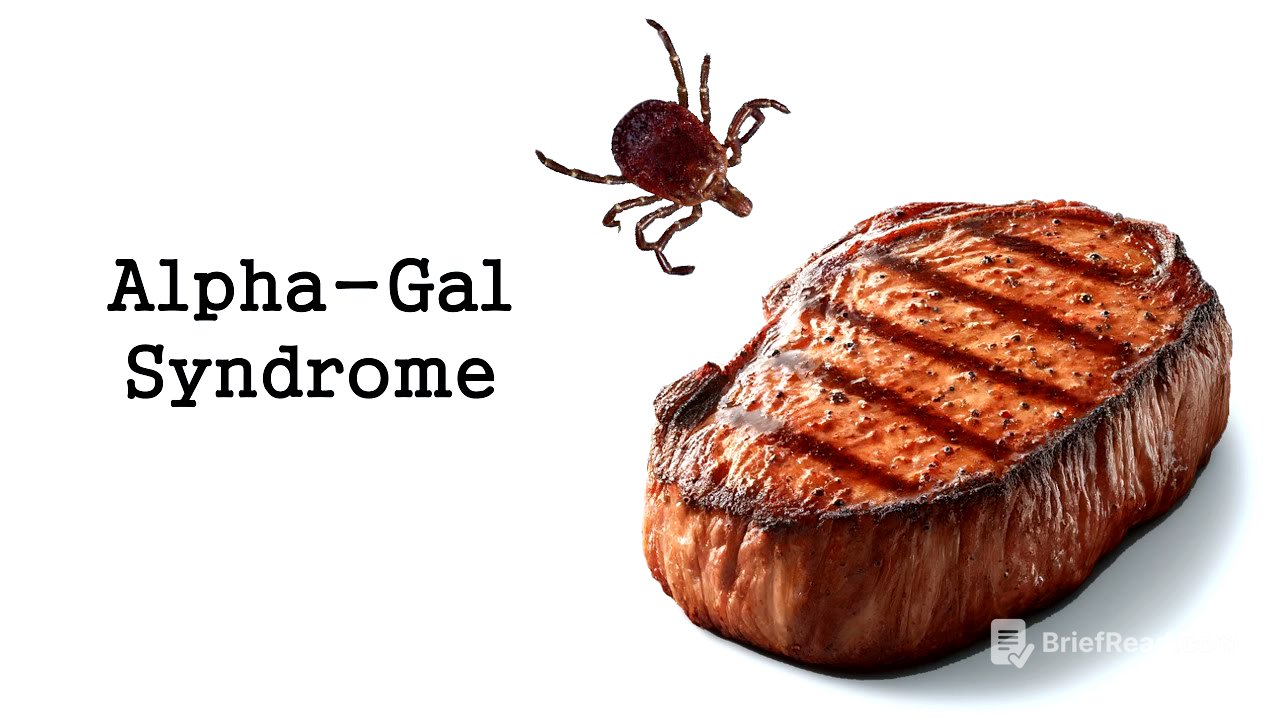TLDR;
This video provides a comprehensive overview of Alpha-gal syndrome, an acquired allergy to red meat and other mammal products triggered by tick bites. It covers the clinical features, affected foods, underlying mechanisms, diagnosis, differential diagnosis, and treatment options.
- Alpha-gal syndrome is an acquired allergy to red meat and mammal products, often triggered by tick bites.
- Symptoms can include itching, hives, swelling, abdominal pain, nausea, and anaphylaxis, with a delayed onset of 2-6 hours after consuming red meat.
- Diagnosis involves a consistent history of reactions to mammal meat and elevated serum Alpha-gal IgE levels.
- Treatment primarily involves avoiding mammal food products and future tick bites, along with general allergy management.
Introduction to Alpha-gal Syndrome [0:05]
Alpha-gal syndrome is an allergic reaction to red meat triggered by tick bites, leading to systemic skin and gastrointestinal issues. This condition, while seemingly rare, is actually quite real and not uncommon. The allergy develops in adulthood, even after years of consuming meat without problems.
Clinical Features and Symptoms [0:46]
The classic presentation of Alpha-gal syndrome resembles a type 1 hypersensitivity reaction, including itching (pruritus), hives (urticaria), swelling of mucous membranes (angioedema), abdominal pain, nausea, and potentially fatal anaphylaxis. A key difference from typical allergies is the delayed onset of 2 to 6 hours between meat consumption and symptom development, often causing patients to wake up with symptoms after dinner. Alcohol, NSAIDs, and physical exertion can increase the likelihood of a reaction. Non-classic symptoms include isolated abdominal pain, joint pains, weight loss, and chronic spontaneous urticaria, making diagnosis challenging.
Trigger Foods and Safe Alternatives [2:20]
Beef, pork (including lard), and lamb are the most common triggers for Alpha-gal syndrome. In some regions, bison, venison, rabbit, and bear meat should also be avoided. Some individuals react only to organ meats like pork kidney, liver, or sweetbreads (calf or lamb thymus/pancreas). A minority of patients also react to dairy. Safe foods include poultry (chicken, duck, goose, turkey, pheasant) and seafood, as well as reptiles and amphibians. Be cautious of hidden mammal products in foods like sausages, refried beans, baked beans, baked goods, and mashed potatoes.
Other Related Allergies and Considerations [3:56]
Alpha-gal patients may also experience life-threatening allergies to medications like cetuximab (a monoclonal antibody) and heparin. Reactions to these medications tend to be more rapid due to direct injection into the bloodstream. Gelatin is another potential issue, found in many products including medication capsules, though serious reactions are uncommon. Most gelatin allergies are unrelated to Alpha-gal syndrome.
Pathophysiology: The Role of Ticks and Alpha-gal [5:01]
Alpha-gal syndrome was first identified in 2006 due to allergic reactions to cetuximab. The reaction was linked to pre-existing IgE antibodies against the oligosaccharide galactose-alpha-1,3-galactose (Alpha-gal) present in the drug. Red meat is rich in Alpha-gal, and individuals with this allergy also showed delayed reactions to it. The lone star tick is associated with triggering the increase in anti-Alpha-gal IgE. The exact mechanism is still unclear, but it's speculated that ticks introduce Alpha-gal or a similar oligosaccharide into the human bloodstream, prompting an immune response. Humans, apes, and Old World monkeys do not express Alpha-gal due to a genetic mutation, which may explain why the immune system targets it as foreign.
Diagnosis of Alpha-gal Syndrome [9:35]
Diagnosis requires both a consistent history of reactions to mammal meat products and elevated serum Alpha-gal IgE levels. Elevated IgE alone is insufficient without a relevant clinical history. There is no consensus on a specific threshold for IgE elevation. Diagnosis is confirmed by symptom resolution on a mammal-free diet.
Differential Diagnosis [10:13]
The differential diagnosis includes other food-related allergies, such as conventional food allergies and other red meat allergies like primary beef allergy (bovine albumin) and pork-cat syndrome. Other considerations are chronic spontaneous urticaria, mast cell disorders, hereditary angioedema, and, in cases with only GI symptoms, irritable bowel syndrome.
Treatment and Prognosis [11:11]
Treatment involves avoiding mammal food products, and often dairy products. Avoiding future tick bites is crucial, as repeated bites can maintain or increase Alpha-gal IgE levels. General severe allergy treatment, including an EpiPen, is recommended. Allergists are the best specialists to manage this condition. While there is no conventional cure, some patients' Alpha-gal IgE levels normalize with complete avoidance of tick bites, allowing for cautious reintroduction of red meat.









